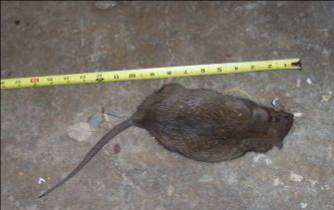Rats are a Worldwide pest due to their capacity to cause
structural damage, to spread life-threatening diseases, and to compete
with man for food. The species most commonly found in Europe is known as
the Norway Rat (Rattus norvegicus). A less commonly found species, the
Black or Roof Rat, (Rattus rattus), is largely restricted to port areas.
Rats live alongside man, invading his buildings and eating his food.
Rats transmit disease which are potentially fatal to man such as Weil's
disease and murine typhus. They also carry organisms that can damage
human health such as Salmonella bacteria, viruses and parasites such as
nematodes and worms. Damage by rats to the fabric of buildings can be
costly. Fires can easily be started after a rat has gnawed a cable. Gas
and water pipes are also at risk and rat burrowing can undermine
foundations and damage watercourses.
Characteristics:
Physically very strong, rats have
been known to survive for two days in open water, to swim a mile in open
sea and to get through a gap of less than 1 INCH (25mm). Rattus norvegicus Common
Names: Norway rat; Common rat; Brown rat; Wharf rat; Sewer rat Adult
Weight: 300 grms Length (head + body): 8 to 10 in. (200-250 mm) Length (tail):
6-8 in (150-200mm), shorter than head and body. Fur, color: Harsh and shaggy.
Brown and black on upper head and body, grey or off-white underneath.
Ears, hearing:
Thick, opaque, short with fine hairs. Excellent sense of
hearing.
Eyes, sight:
Small. Poor sight, color-blind.
Snout, smell and
taste:
Blunt, Excellent sense of smell and taste.
Droppings:
In groups,
but sometimes scattered. Ellipsoidal capsule shaped, about 20mm long.
Habits, habitat:
Does burrow. Lives outdoors, indoors and in sewers.
Nests in burrows. Can climb though not agile. Very good swimmer.
Conservative, somewhat predictable in habit. Will avoid unfamiliar
objects, e.g. bait trays, placed on runs, for some days. Range
approximately 55yards (50 meters).
Feeding habits:
Omnivorous, more likely to eat meat than Rattus rattus.
Consumes up to 30 grams per day, drinks water or eats food with high
water content.
Life cycle:
Span: 9-18 months. Sexual maturity: 2-3
months. Litter size: 8-10 offspring. Maximum reproduction rate: 7
litters per year. Rattus rattus Common Names: Ship rat; Black rat; House
rat; Roof rat. Adult Weight: 200 grams Length (head + body): 6-8.5 in (150-220mm)
Length (tail): 7-10 in (180-250mm), usually longer than head and body. Fur, color:
Smoother and softer than Rattus norvegicus. Usually black or grey Ears.
Hearing:
Thin, translucent, large and hairless. Excellent sense of
hearing.
Eyes, sight:
Large and prominent. Poor sight,
color blind.
Snout, smell and taste:
Pointed, Excellent sense of smell and taste.
Droppings:
Scattered. Spindle or banana-shaped, about 12mm long. Habits,
habitat: Non-burrowing. Nests mainly in walls, attics, vines and trees.
Active agile climber, rarely found in sewers. Rather more erratic and
unpredictable in habit than Rattus norvegicus. Less wary of new objects
than Rattus norvegicus. Range 30 metres.
Feeding habits:
Omnivorous,
mainly fruits, nuts, grains and vegetables. Consumes 25-30 grams per
day, drinks water or eats food with high water content. Life cycle:
Span: 9-12 months. Sexual maturity: 2-3 months. Litter size: 6-10
offspring. Maximum reproduction rate: 6 litters per year.

